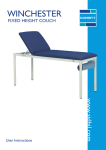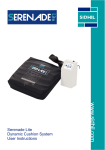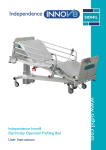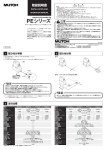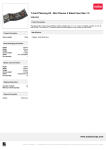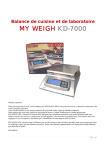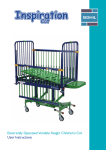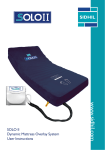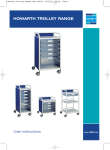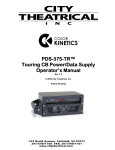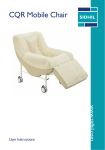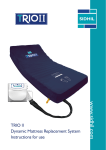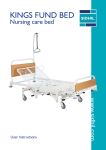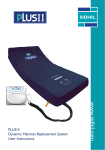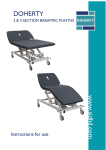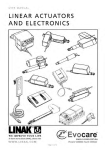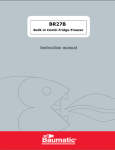Download Portable Bedhead Hoist
Transcript
Portable Bedhead Hoist www.sidhil.com Portable Electric Hoist User Instructions CONTENTS 1. INTRODUCTION 4 1.1 Features 4 1.2 Warnings & Cautions 4 2. USE 5 2.1 Typical Use 2.2 Single Leg Configuration 2.3 Double Leg Configuration 2.4 Risk Assessment 2.5 Safe Working Load 2.6 General Warning 5 5 6 6 7 7 2.7 Regulatory Requirements 7 3. SYMBOL DEFINITION 4. PARTS IDENTIFICATION 5. HOIST ASSEMBLY AND PREPARING FOR USE 8 9 10 5.1 Hoist Assembly 10 6. HOIST DISASSEMBLY AND PREPARING FOR STORAGE 17 6.1 Hoist Disassembly 17 7. OPERATING THE HOIST 21 7.1 Electrical System 7.2 Variable Height Adjustment 7.3 Emergency Lowering Device 21 21 22 7.4 Hoist Lifting Safety Limit 22 8. CLEANING PROCEDURES 23 8.1 Infection Control 8.2 Decontamination 23 23 8.3 Cleaning the Sling 24 9. MAINTENANCE & TROUBLESHOOTING 25 9.1 General Maintenance 25 9.2 Fault Finding 26 10. SPECIFICATION 27 10.1 Hoist Data 27 10.2 General Electrical Data 28 10.3 Electrical Product Specific Data 28 11. OPTIONAL ACCESSORIES 29 12. WARRANTY 30 3 1. INTRODUCTION 2. USE Thank you for purchasing a Sidhil Portable Electric Bedhead Hoist. The user manual should be read carefully before operating the hoist in order to ensure safe operation and maintenance. Please ensure that all instructions are fully understood and should any questions arise concerning the operation or maintenance of the hoist please contact your provider. 2.1 Typical Use 1.1 Features • Portable electric bedhead hoist • Designed for everyday indoor use as an aid to transfer a person from bed to chair, wheelchair, commode or other similar item • Increased maximum patient user weight of up to 24 Stone (152kg) • Breaks down into easily manageable sections Your Sidhil Portable Bedhead Hoist is intended for use within a patient home or care home environment. It has been designed to provide a safe and easy method of transferring a patient from bed to chair, wheelchair, commode or any other such item. The adaptable hoist offers a product where a conventional ceiling track hoist cannot be fitted. Single or double bed 2.2 Single Leg Configuration Long leg • Bespoke transport stand to aid storage and transportation • Fitted with an electric actuator powered by a domestic mains power supply • Integral manual lowering device Non-Patient transfer side • Protected by BioCote® surface paint ensuring the product remains fully protected against the spread of harmful bacteria 1.2 Warnings and Cautions Warnings in this user manual highlight potential hazards that if disregarded could lead to injury or death. Cautions in this user manual highlight potential hazards that if disregarded could lead to equipment damage or failure. Patient transfer side Medium leg Limiting screw Short leg Warning The hoist must always be limited to the patient transfer side. Ensure the limiting screw is located to the opposite side of the patient transfer side. This prevents the arm from swinging onto the nonpatient side making the hoist unstable. 4 5 2. USE 2. USE 2.3 Double Leg Configuration 2.5 Safe Working Load (S.W.L) An additional leg is required for this configuration and is supplied as an accessory (HST14). The safe working load of the hoist is 24 Stone (152kg). 2.6 General Warning Long Leg Warning Misused electrical equipment can be hazardous. Accessories that have not been approved or designed for use with the hoist must not be used. Single or double bed The hoist should always be limited to a patient transfer side unless two medium (HST13/307) legs are deployed. The hoist should always be positioned away from direct heat i.e. away from radiators, fan heaters or any other external heat source. Particular attention should be made to ensure the electrical control box is not positioned close to a heat source. Patient transfer to both sides Medium leg Medium leg DO NOT ALLOW BOOM ARM IN THIS AREA Warning Ensure the limiting screw is removed to allow the boom to move in a 170° motion. Do not permit the hoist arm to be operated beyond the area indicated as shown above. 2.7 Regulatory Requirements Regulations (LOLER ’98) require that carers are trained in accordance with this directive in order to operate the hoist. This user guide complements this training; it is not a substitute and is offered for guidance only. Should training be required please contact your equipment supplier or provider. LOLER ’98 states that all lifting equipment is thoroughly examined at six monthly intervals and all examination records are retained for inspection. 2.4 Risk Assessment Prior to patient/carer use of the hoist a comprehensive risk assessment must be performed on a patient by patient basis. A risk assessment should include, but is not limited to; • The weight of the patient - not exceeding 24 Stone (152kg) • Falling out of the bed/sling during patient transfer • Small children (and adults) • Point of transfer (deploying a single or double leg configuration) • Unauthorised persons 6 7 3. SYMBOL DEFINITION 4. PARTS IDENTIFICATION The following symbols are found on this hoist: 1. Long Leg (HST13/301) 2. Medium Leg (HST13/307) 3. Short Leg (HST13/302) Warning 1 4. Transport Stand (HST13/TS) 5. Top Tube Assembly (HST13/311) 6. Boom Assembly (HST13/312) 7. Spreader Bar (7000) 5 8. Middle Tube Assembly (HST13/134) 6 9. Base Assembly (HST13/310) Refer to user guide 10. CB6S Control Box (CONTROL/089) 11. LA44 Actuator (ACTU/045) 2 12. Electrical Pack (included - not shown) - Handset (CONTROL/088) - Actuator Cable (CABLE/015) Maximum user weight & safe working load 3 - Mains Lead (CABLE/032) - Cable Retainer (CABLE/089) - Blanking Plug (CONTROL/030) - User Guide (INSTRUC/HST13) Place of manufacture 8 4 11 W.E.E.E Label (Do not discard in general waste, follow local recycling policy) 8 7 9 10 9 5. HOIST ASSEMBLY AND PREPARING FOR USE 5. HOIST ASSEMBLY AND PREPARING FOR USE Caution Unscrew hand wheel to release base assembly Before attempting to assemble the hoist please ensure these instructions have been read and clearly understood. It is advisable to assemble the hoist with a second able bodied person. Prior to assembly ensure all items are provided as indicated in Section 4 – ‘Parts Identification’. Clear the area of any obstructions and ensure the surface is level. Ensure the castor brakes are applied prior to removing items from the transport stand. Base assembly (HST13/306) Take care when disassembling each part from the transport stand, as each part/component is of considerable weight. • Position the base assembly at the head end of the bed, ensuring the floor area is clear of obstacles and the surface is level. 5.1 Hoist Assembly • A 5mm allen key is provided on the transport stand to aid assembly. • Offer the three stabilising legs (1 x short, 1 x medium & 1 x long leg) to the base assembly. Ensure the longest leg is positioned to fit underneath the bed. Ensure the medium length leg is inserted into the base assembly on the patient transfer side. Insert the shortest leg to the opposite side. Secure all legs with the 5mm allen key. 5mm allen key • When fitting a HST13 (accessory medium leg) in place of the short leg, leave the short leg on the transport stand. • Using the 5mm allen key loosen all fastenings to enable removal of parts from the transport stand. • Loosen the hand wheel on the transport stand that holds the base assembly in place and then lift this off the stand and carefully place flat on the floor. Base assembly (HST13/310) Medium leg (HST13/307) Long leg (HST13/301) Short leg (HST13/302) Loosen fixings to remove legs 10 Bolts to secure legs in position 11 5. HOIST ASSEMBLY AND PREPARING FOR USE 5. HOIST ASSEMBLY AND PREPARING FOR USE • • • • The levelling foot can be adjusted to suit varying and uneven floor surfaces. Ensure the assembled hoist base and legs are completely stable on the floor surface by adjusting the levelling foot as necessary. Ensure the boom is fully secure within the top assembly and the lynch pin is fully engaged into the clevis pin, to proceed in fitting the actuator. Lynch Pin (PIN/001) Levelling foot in fully lowered position Ensure the limiting screw is loosened sufficiently to insert the top assembly (including boom & spreader bar) into the base assembly. Locate and position within the central column. Clevis Pin (CP/003) • Ensure the top of the actuator is fitted and secured to the boom arm first with the clevis and lynch pins. The base of the actuator is subsequently offered to the hoist upright and secured. Ensure the limiting screw in the correct position to limit movement of the boom to the patient side of the bed only. Ensure the transport stand that holds the base assembly is in place and then lift this off the stand and carefully place flat on the floor. Levelling foot in raised position Top of actuator Boom arm Limiting screw positions Clevis Pin (CP/003) Warning • Ensure the boom is supported when fitting the top assembly, to prevent clashing with the central column and causing damage. • Ensure the limiting screw is positioned correctly to limit the arm movement to the patient transfer side of the bed only. 12 Lynch Pin (PIN/001) Caution Do not hang the actuator from the bottom pivot. Do not allow the actuator to swing from the top pivot. Ensure the actuator is supported at all times whilst being assembled. Ensure the body of the actuator is positioned in the correct . orientation to prevent collision with a wall. 13 5. HOIST ASSEMBLY AND PREPARING FOR USE 5. HOIST ASSEMBLY AND PREPARING FOR USE • Locate the locking ring on the underside of the actuator and turn into the unlocked position. • Route the control box cable to the actuator securing the wire into the clips provided. Locking ring • Position and secure the cable into the socket. Holding the locking ring, turn clockwise to fully lock at 90°. • Plug the handset cable into Port 5 on the control box socket. Actuator cable inserted Control box • Plug the opposite end of the cable into Port 1 on the control box. Handset cable Actuator cable Control box 14 15 5. HOIST ASSEMBLY AND PREPARING FOR USE 6. HOIST DISASSEMBLY AND PREPARING FOR STORAGE Caution Actuator Port Ensure all cables are disconnected from the power supply and control box prior to dismantling the hoist. Handset Port Mains Port Power Light 6.1 Hoist Disassembly • Remove the cable retainer from the control box by un-clipping with a flat bladed screw driver. • Clip the cable retainer into the control box in the orientation shown to prevent the cables loosening. To attach the retainer ensure to feed the plug cables through the relevant slot and push the retainer around the plug. Clip the retainer into the control box to secure. • Remove the mains cable by placing a flat bladed screw driver into the power port slot to dislodge the tabs on the red locking ring. Once dislodged, the mains cable can be released. Cable retainer • Attach the mains cable to the control box, by lining up the 2 pin male connector with the 2 pin female port on the control box. Ensure to engage the red retention clip. Plug the three pin plug to a domestic power supply. Spring clip Plastic washer • The spreader bar is pre-assembled to the boom. However, should the spreader bar be removed, attach the bar to the end of the boom arm using the pin, washers and spring clips. Ensure a washer is positioned at each side of the boom arm and the spring clips are fully located. • Separate the hoist into its individual parts to locate on the transport stand. • The hoist is now ready to use. 16 17 6. HOIST DISASSEMBLY AND PREPARING FOR STORAGE Short leg location Long leg location 6. HOIST DISASSEMBLY AND PREPARING FOR STORAGE • Position the actuator within the brackets as shown and secure with clevis & lynch pins. Bracket ‘Spare’ medium leg location Spreader bar location Actuator Actuator location • Firstly, position the base assembly onto the transport stand in the orientation shown. Remember to secure the hand wheel to fully secure the base assembly. Bracket Medium leg location Base assembly positioned on transport stand • Insert the top assembly, boom and spreader bar assembly into the middle tube of the base assembly. Locate the spreader bar and secure onto the transport stand bracket. Top assembly • Ensure all legs are positioned in the correct location tubes. Secure legs into their respective tube by tightening the leg bolt. 18 19 6. HOIST DISASSEMBLY AND PREPARING FOR STORAGE 7. OPERATING THE HOIST 7.1 Electrical System Long leg Medium leg Typical leg bolt to secure into tube The hoist has an electrical adjustable boom height with a backup manual lowering device to aid patient transfer. The system is controlled via a touch button handset. Short leg • Ensure all clevis and lynch pins are fully secured to the transport stand and all parts are stable. 7.2 Variable Height Adjustment Before operating the handset always advise a patient of the action due to commence. • To raise the hoist, depress the up arrow on the handset to the desired height. • To lower the hoist, depress the down arrow on the handset to the desired height. Lynch pin Clevis pin • The hoist automatically stops when the maximum or minimum heights are achieved. • The control box is pre-installed with software to cut-out the actuator should the hoist be over loaded above 24 stone (152Kg) safe working load (SWL). • Ensure the handset is located on the handset holder when not in use. 20 21 7. OPERATING THE HOIST 8. CLEANING PROCEDURES 7.3 Emergency Lowering Device 8.1 Infection Control • In case of power failure, the actuator incorporates a mechanical lowering device to lower a patient suspended in the hoist. Your hoist comes with an antibacterial additive incorporated into the powder coated metalwork. Biocote® inhibits the growth of bacteria on the surface of the hoist frame. It is effective against a wide range of both gram positive and negative bacteria as well as fungi. Examples of bacteria that Biocote® is resistant to include: • Bacillus Subtilis • To operate, twist the manual device in a clockwise direction to lower the hoist. • Staphylococcus Aureus (MRSA) • Escerichia Coli 0157 Mechanical lowering device • Always ensure a patient is aware when lowering the hoist manually. • Streptococcus Faecalis • Salmonella Enteritides • Listeria Monocytogenes Warning 7.4 Hoist Lifting Safety Limit • The control box on the Sidhil Electric Hoist contains an electronic current limiter. This will ensure the hoist will only ever lift the maximum 24 Stone (152kg) load. • The current limiter will be triggered when the hoist has been loaded above and beyond 24 Stone (152kg). When overloaded, the hoist will have a stop start motion within the final third of the lifting range with the up button depressed on the handset. • Should this occur lower the hoist immediately. 22 Biocote® is an aid to keeping your hoist infection free but it does not substitute the need for the hoist to be cleaned at regular intervals. Always disconnect the control box from the main power supply prior to cleaning. 8.2 Decontamination Infection control and routine cleaning must be carried out in accordance with your local infection control policy or regulatory body. Warning Always disconnect the hoist from the main power supply prior to cleaning. 23 8. CLEANING PROCEDURES 9. MAINTENANCE & TROUBLESHOOTING 9.1 General Maintenance These instructions apply to all accessories apart from soft products (e.g. slings). • All surfaces to be wiped down with a disposable soft cloth moistened with a mild detergent and diluted in warm water (40°C). • The hoist should be cleaned by starting with the cleanest parts of the frame and systematically moving to the dirtiest parts. Extra care should be taken around areas where excess dirt or dust may gather. • The cloth should be changed during the cleaning process if it becomes soiled. Only authorised service personnel or Sidhil service engineers should carry out repairs or service activities. Failure to do so may result in the manufacturer’s warranty becoming void. The hoist must be serviced every six months, as a minimum and records of the inspections maintained and kept for review. Sidhil also recommends that the carer performs frequent visual and operational inspections. If there are any signs of damage or the hoist is not performing as it should, withdraw it from service until the hoist has been repaired and is fit for use again. • Rinse down with clean water to remove detergent residue. • Wipe surfaces down with 1,000 parts per million chlorine solution (0.1%). Warning Always disconnect the hoist from the main power supply prior to performing any maintenance procedures. • Dry off with a paper towel. • Always ensure the cleaned parts are allowed to dry before attaching a sling. Note: If any of the 3 stages stated above (detergent, rinse down & chlorine solution) are omitted or combined it will reduce the effectiveness of the clean. In cases of blood spills or other bodily fluids it is recommended that a chlorine solution of 10,000 parts per million (1%) is used instead. Note: The use of neat bleach or similar surface cleaners are not recommended as damage may be caused to the cleaned surfaces. Alternatively, Sidhil recommend the use of Chlor-clean tablets. Follow the manufacturer’s instructions for concentration guidelines and instructions for use. Refer to the Sidhil infection control policy, copies are available from Sidhil Ltd. Contact details can be found on the back of this booklet. Periodically: • Check for any signs of tearing, split seams or other forms of damage to the sling. • Check that the spreader bar rotates freely without excessive play. • Check that the frame is mechanically sound. • Check that all nuts, bolts and fasteners are tight and that none are missing or incomplete. • Check that all the clevis pivot pins are secure and retained with the appropriate lynch pins. • Ensure the stabilising legs are fully secure. Disposal of components must comply with local policy. 8.3 Cleaning the Sling Please review the user instructions supplied with the sling for cleaning guidelines. 24 25 9. MAINTENANCE & TROUBLESHOOTING 10. SPECIFICATION 9.2 Fault Finding 10.1 Hoist Data Listed below are a set of electrical faults that may occur within the service life of the hoist. If a fault does occur please try the following suggestions, as these may help in diagnosing the fault. Overall width (single configuration) 2022mm Overall width (double configuration) 2834mm Overall length 1974mm Spreader bar (highest position from floor) 1822mm Spreader bar (lowest position from floor) 1083mm Warning Do not use the hoist until the fault has been resolved. Fault Possible Cause Remedy Hoist does not raise or lower. Mains lead not plugged into the mains supply. Check that mains lead is plugged into the mains supply and the supply is switched on. Mains lead not plugged into the control box or is only partially plugged in. Check that mains lead is fully located into the control box. Overall height (floor to top of boom) 2048mm Fuse has blown in the mains plug. Check the power light is illuminated on the control box and replace the 5A fuse if necessary. Central column height 1665mm Actuator or handset leads are unplugged or only partially plugged in. Check that both leads are fully plugged into the control box. Central column height (to remove during assembly) 2100mm Actuator has reached its maximum or minimum stroke. Depress each button on the handset to assess hoist movement. Should the hoist be at its highest position, lower using the emergency lowering nut on the actuator and contact your supplier. Damage to mains cable, actuator cable or handset cable. Turn off at the mains and contact your supplier. Damage to actuator. Maximum load exceeded. The hoist fails mid operation. The duty cycle of the hoist is being exceeded. Ensure that the maximum SWL has not been exceeded. Lower the hoist using the lowering nut or the handset and allow the control box to cool down. The patient is above the 24 Stone (152kg) SWL. Lower patient fully using the emergency lowering nut or the handset and do not exceed the SWL. 26 Safe working load (user weight) Product weight: 152kg (24 stone) Hoist on transport stand 62 kg Hoist 50 kg 27 11. OPTIONAL ACCESSORIES 10. SPECIFICATION 10.2 General Electrical Data General voltage in 230V AC ±10%, 50Hz Safety standards EMC BS EN 60601-1-2:2006 (Medical Electrical System) Electrical shock protection Liquid ingress protection Universal Sling (Small) HST09/M Universal Sling (Medium) HST09/L Universal Sling (Large) HST09/XL Universal Sling (X- Large) HST10/S Commode Sling (Small) HST10/M Commode Sling (Medium) HST10/L Commode Sling (Large) HST10/XL Commode Sling (X- Large) HST11/S Head Support for Universal Sling (Small) HST11/M Head Support for Universal Sling (Medium) HST11/L Head Support for Universal Sling (Large) IP54 The electrical system is only suitable for use when: Ambient temperature +5° to +40°C Humidity HST09/S 20% - 90% at 30°C 10.3 Electrical Product Specific Data Product: LA44 LINAK Actuator Article no: 442205+5L2000A0 Thrust: 12000N Speed: 10.4/6.0 mm/s Stroke length: 200mm Installation length: 548mm Motor: 24V DC standard Protection class: IPX4 Colour: Grey Product: Mains Cable Article no: 912049 (CONTROL/032) Cable length: 3.2 Mtr Extra feature: Locking O Ring Colour: Black PVC Product: LA44 LINAK Actuator Cable Article no: 0964424-0500 Cable length: 500mm straight Colour: Grey Product: CB6S LINAK Control Box Article no: CB6217-00 Mains voltage: 230V AC Output voltage: 24V DC No. of channels: 2 Duty cycle: 10% (or 6 min./hour) Current cut-off: Special S/W Protection class: IPX4 Colour: Grey Product: HB80 LINAK Handset Article no: HB8X072-00 No. of channels: 1 Cable length: 600mm Coiled Protection class: IPX4 Colour: Grey PU 28 29 12. WARRANTY Sidhil Ltd guarantees this product is free from defects in material and workmanship under normal use for 3 years (1 year parts and labour, 2 further years for parts only) from the date of purchase from Sidhil Ltd and its subsidiary companies or its authorised dealers. All implied warranties, including but not limited to those implied warranties of fitness and merchantability, are limited in the total duration of three years from date of purchase. Proof of purchase must be presented with any claim. Except as provided herein, Sidhil Ltd, product warranty does not cover damage caused by misuse or abuse, accident, the attachment of any unauthorised accessory, alteration to the product, or any other conditions whatsoever that are beyond the control of Sidhil Ltd. Sidhil Ltd and its subsidiary companies shall have no liability or responsibility to the customer or any other person or entity with respect to any liability, loss or damage caused direct or indirectly by use or performance of the product or arising out of any breach of this warranty, including but not limited to any damages resulting from inconvenience, loss of time, property, revenue, or profit or any indirect, special, incidental or consequential damages, even if Sidhil Ltd or their subsidiary companies or authorised dealers has been advised of the possibility of such damages. In the event of a product defect during the warranty period you should contact Sidhil Ltd or their authorised dealer who will at its option unless otherwise provided by law; a) correct the defect by product repair without charge for parts and labour b) replace the product with one of the same or similar design or c) refund the purchase price. All replaced parts and products on which refund is made become the property of Sidhil Ltd. New or reconditioned parts and products may be used in the performance of warranty service. Repaired or replaced parts and products are warranted for the remainder of the original warranty period. You will be charged for repair or replacement of the product made after the expiration of the warranty period. This warranty does not cover; a) damage or failure by or attributes to acts of God, abuse, accident, misuse, improper or abnormal usage, failure to follow instructions, improper installation or maintenance, alterations, lightning or other incidence of excess voltage or current, b) any repairs other than those provided by a Sidhil Ltd authorised technician, c) consumables such as fuses, d) cosmetic damage, e) transportation, shipping or insurance costs or f) costs of product removal, installation setup service adjustment or re-installation. This limited 1 year warranty gives you specific legal rights and you may also have other rights. Sidhil Ltd cannot be held responsible for any injury or incident which relates to the use of this hoist in conjunction with accessories manufactured by companies other than Sidhil Ltd. All products carry the CE mark in accordance with EC Directive on Medical Devices (93/42/EEC). Sidhil has a policy of continual product improvement and reserves the right to amend specifications covered in this brochure. No part of this brochure may be reproduced without the written approval of Sidhil Ltd. 30 CONTACT INFORMATION Tel: 01422 233000 Fax: 01422 233010 Email: [email protected] www.sidhil.com Sidhil Business Park, Holmfield, Halifax, HX2 9TN A member of the Siddall & Hilton Ltd. Group of Companies (93/42/EEC) Certificate No. FM14550 INSTRUC/HST13 - 09.01.12 - Rev - 2


















